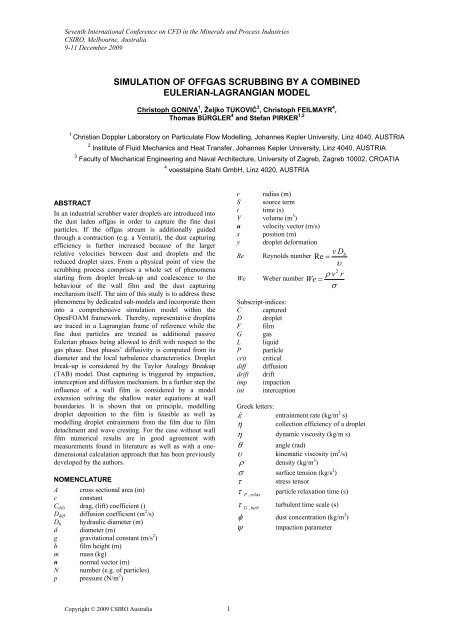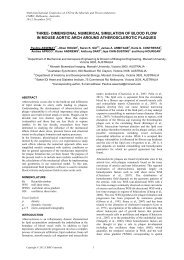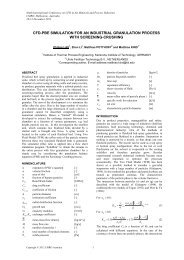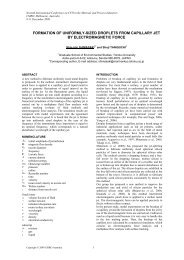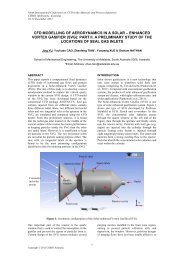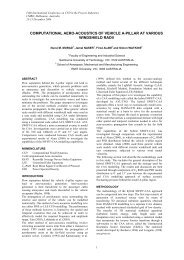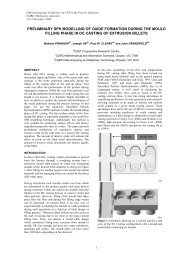simulation of offgas scrubbing by a combined eulerian ... - CFD
simulation of offgas scrubbing by a combined eulerian ... - CFD
simulation of offgas scrubbing by a combined eulerian ... - CFD
You also want an ePaper? Increase the reach of your titles
YUMPU automatically turns print PDFs into web optimized ePapers that Google loves.
Seventh International Conference on <strong>CFD</strong> in the Minerals and Process Industries<br />
CSIRO, Melbourne, Australia<br />
9-11 December 2009<br />
SIMULATION OF OFFGAS SCRUBBING BY A COMBINED<br />
EULERIAN-LAGRANGIAN MODEL<br />
Christoph GONIVA 1 , Željko TUKOVIĆ 3 , Christoph FEILMAYR 4 ,<br />
Thomas BÜRGLER 4 and Stefan PIRKER 1,2<br />
1 Christian Doppler Laboratory on Particulate Flow Modelling, Johannes Kepler University, Linz 4040, AUSTRIA<br />
2 Institute <strong>of</strong> Fluid Mechanics and Heat Transfer, Johannes Kepler University, Linz 4040, AUSTRIA<br />
3 Faculty <strong>of</strong> Mechanical Engineering and Naval Architecture, University <strong>of</strong> Zagreb, Zagreb 10002, CROATIA<br />
ABSTRACT<br />
In an industrial scrubber water droplets are introduced into<br />
the dust laden <strong>of</strong>fgas in order to capture the fine dust<br />
particles. If the <strong>of</strong>fgas stream is additionally guided<br />
through a contraction (e.g. a Venturi), the dust capturing<br />
efficiency is further increased because <strong>of</strong> the larger<br />
relative velocities between dust and droplets and the<br />
reduced droplet sizes. From a physical point <strong>of</strong> view the<br />
<strong>scrubbing</strong> process comprises a whole set <strong>of</strong> phenomena<br />
starting from droplet break-up and coalescence to the<br />
behaviour <strong>of</strong> the wall film and the dust capturing<br />
mechanism itself. The aim <strong>of</strong> this study is to address these<br />
phenomena <strong>by</strong> dedicated sub-models and incorporate them<br />
into a comprehensive <strong>simulation</strong> model within the<br />
OpenFOAM framework. There<strong>by</strong>, representative droplets<br />
are traced in a Lagrangian frame <strong>of</strong> reference while the<br />
fine dust particles are treated as additional passive<br />
Eulerian phases being allowed to drift with respect to the<br />
gas phase. Dust phases’ diffusivity is computed from its<br />
diameter and the local turbulence characteristics. Droplet<br />
break-up is considered <strong>by</strong> the Taylor Analogy Breakup<br />
(TAB) model. Dust capturing is triggered <strong>by</strong> impaction,<br />
interception and diffusion mechanism. In a further step the<br />
influence <strong>of</strong> a wall film is considered <strong>by</strong> a model<br />
extension solving the shallow water equations at wall<br />
boundaries. It is shown that on principle, modelling<br />
droplet deposition to the film is feasible as well as<br />
modelling droplet entrainment from the film due to film<br />
detachment and wave cresting. For the case without wall<br />
film numerical results are in good agreement with<br />
measurements found in literature as well as with a onedimensional<br />
calculation approach that has been previously<br />
developed <strong>by</strong> the authors.<br />
NOMENCLATURE<br />
A cross sectional area (m)<br />
c constant<br />
Cd(l) drag, (lift) coefficient ()<br />
Ddiff diffusion coefficient (m 2 /s)<br />
Dh hydraulic diameter (m)<br />
d diameter (m)<br />
g gravitational constant (m/s 2 )<br />
h film height (m)<br />
m mass (kg)<br />
n normal vector (m)<br />
N number (e.g. <strong>of</strong> particles)<br />
p pressure (N/m 2 )<br />
Copyright © 2009 CSIRO Australia 1<br />
4 voestalpine Stahl GmbH, Linz 4020, AUSTRIA<br />
r radius (m)<br />
S source term<br />
t time (s)<br />
V volume (m 3 )<br />
u velocity vector (m/s)<br />
x position (m)<br />
y droplet deformation<br />
Re Reynolds number<br />
v Dh<br />
Re =<br />
υ<br />
2<br />
ρ v r<br />
We Weber number We =<br />
Subscript-indices:<br />
C captured<br />
D droplet<br />
F film<br />
G gas<br />
L liquid<br />
P particle<br />
crit critical<br />
diff diffusion<br />
drift drift<br />
imp impaction<br />
int interception<br />
Greek letters:<br />
ε& entrainment rate (kg/m 2 s)<br />
η collection efficiency <strong>of</strong> a droplet<br />
η dynamic viscosity (kg/m s)<br />
θ angle (rad)<br />
υ kinematic viscosity (m 2 /s)<br />
ρ density (kg/m 3 )<br />
σ surface tension (kg/s 2 )<br />
σ<br />
τ stress tensor<br />
τ particle relaxation time (s)<br />
P , relax<br />
τ G , turb turbulent time scale (s)<br />
φ dust concentration (kg/m 3 )<br />
ψ impaction parameter
INTRODUCTION<br />
Due to the increasingly restricting legislation for the<br />
emission <strong>of</strong> pollutants there is a necessity for improved<br />
cleaning devices. Among the equipment utilised for<br />
cleaning <strong>of</strong> gases prior to release into the atmosphere, a<br />
Venturi wet scrubber, is one <strong>of</strong> the most effective. It can<br />
remove particles suspended in gaseous streams, achieving<br />
very high efficiencies even for particles <strong>of</strong> the order <strong>of</strong><br />
micrometers (Dullien ,1989).<br />
In Fig. 1 a Venturi scrubber is sketched. On principle, it<br />
comprises a convergence, a throat, and a diffuser. Dust<br />
laden gas enters the Venturi scrubber and accelerates in<br />
the convergence section. Due to the fact that the dust<br />
particles are very small they follow the gas stream nearly<br />
ideally. In the throat, the <strong>scrubbing</strong> liquid is injected and<br />
accelerated through drag force acting on the liquid<br />
droplets. As a result <strong>of</strong> the relative velocity between the<br />
droplets and the dust particles collisions occur and<br />
therefore the dust is captured <strong>by</strong> the droplets. The main<br />
collision mechanism in a Venturi scrubber is inertial<br />
impaction. Other collision mechanisms, such as<br />
interception and Brownian diffusion, are insignificant in<br />
comparison with inertial impaction (Boll, 1973). In a<br />
subsequent cyclone separator the droplets, whose<br />
diameters are much larger than the dust particles’, can be<br />
removed from the gas stream.<br />
Figure 1: Principle sketch <strong>of</strong> a Venturi scrubber.<br />
Venturi scrubbers can be classified as either a liquid<br />
injection type (Pease–Anthony type) or a wetted approach<br />
type according to how the liquid is supplied (Pulley,<br />
1997).<br />
In the Pease-Anthony scrubber the <strong>scrubbing</strong> liquid is<br />
injected through orifices which are located at the throat.<br />
The injected liquid jet breaks up due to aerodynamic<br />
forces acting between the droplets and the gas. In the<br />
wetted approach type scrubber the liquid is introduced as<br />
liquid film that flows along the wall. In that case droplets<br />
are entrained into the gas stream due to shear force acting<br />
between the gas and the liquid film.<br />
The main drawback <strong>of</strong> a Venturi scrubber is its large<br />
power consumption for operation which is determined <strong>by</strong><br />
the pressure drop. As Gonçalves (2001) pointed out, many<br />
computational models are available for the prediction <strong>of</strong><br />
pressure drop in Venturi scrubbers. One <strong>of</strong> the early<br />
models was presented <strong>by</strong> Calvert (1970). It assumes that<br />
all the liquid is atomized into droplets and subsequently<br />
accelerated up to the gas velocity at the end <strong>of</strong> the throat.<br />
Good results were achieved using the model <strong>of</strong><br />
Boll (1973) who derived a differential equation which is<br />
integrated over the Venturi length. The model accounts for<br />
acceleration <strong>of</strong> gas, droplets and wall friction. These<br />
effects were identified <strong>by</strong> Azzopardi (1984) to be the main<br />
Copyright © 2009 CSIRO Australia 2<br />
causes <strong>of</strong> pressure drop in Venturi scrubbers. Recently,<br />
more complex Computational Fluid Dynamics (<strong>CFD</strong>)<br />
models have been used <strong>by</strong> Pak (2006) to calculate the<br />
performance <strong>of</strong> Venturi scrubbers.<br />
The flow in a Venturi scrubber is very complex<br />
comprising the gas flow, liquid dispersed as droplets,<br />
liquid flowing as a film along the wall and dust particles<br />
dispersed in the gas stream. In this paper, the dispersed<br />
three-phase flow <strong>of</strong> the Venturi scrubber is numerically<br />
analysed using a three-dimensional Eulerian–Lagrangian<br />
approach. There<strong>by</strong>, representative droplets are traced in a<br />
Lagrangian frame <strong>of</strong> reference while the fine dust particles<br />
are treated as additional passive Eulerian phases which are<br />
allowed to drift with respect to the gas phase due to<br />
gravitational and centrifugal forces. For the computation<br />
<strong>of</strong> the dust phases’ diffusivity, a model considering the<br />
dust particle diameter and the local turbulence<br />
characteristics is used. Droplet break-up is considered <strong>by</strong><br />
the Taylor Analogy Breakup (TAB) model. For the dust<br />
capturing three mechanisms, namely impaction,<br />
interception and diffusion are considered. In a further step<br />
the influence <strong>of</strong> a wall film coupled with the gas and<br />
droplet phase is addressed <strong>by</strong> a model extension solving<br />
the shallow water equations at wall boundaries. Besides<br />
droplet deposition to the film, this sub-model also handles<br />
droplet entrainment from the film due to film detachment<br />
and wave cresting.<br />
In the next section the mathematical modelling <strong>of</strong> the<br />
complex phenomena is presented in a consecutive way<br />
before in subsequent section the results <strong>of</strong> this model are<br />
compared to experimental data <strong>of</strong> Haller (1989).<br />
The aim <strong>of</strong> this comprehensive representation <strong>of</strong> the<br />
<strong>scrubbing</strong> process is to get a model that is suitable for<br />
arbitrary wet <strong>scrubbing</strong> devices.<br />
MODEL DESCRIPTION<br />
Gas Flow<br />
For the gas flow a Eulerian approach is used solving the<br />
Reynolds averaged Navier-Stokes equations (RANS)<br />
using the standard k-ε turbulence model.<br />
It is assumed that there is no heat transfer between gaswalls,<br />
gas-droplets and gas-dust. The latter two<br />
assumptions postulate that the gas and the droplets (or<br />
dust particles) are at the same temperature which<br />
presumes a strong thermal coupling between the gas and<br />
droplet (or dust particle). Thus, in the following modelling<br />
both droplets and dust particles are assumed inert and<br />
isotherm.<br />
The conservation <strong>of</strong> mass <strong>of</strong> the gas phase can be written<br />
as:<br />
∂ρG<br />
+ ∇⋅<br />
( ρ Gu<br />
G ) = 0 .<br />
∂t<br />
(1)<br />
From the conservation <strong>of</strong> momentum one can derive:<br />
( ρ u )<br />
∂ G<br />
∂t<br />
with<br />
G<br />
+ ∇⋅<br />
( ρ u u ) = −∇p<br />
+ ∇⋅<br />
τ + ρ g + S<br />
G<br />
G<br />
G<br />
T<br />
( η<br />
+ η )( ∇u<br />
+ u )<br />
τ ∇<br />
= G G,<br />
t<br />
G<br />
G<br />
G<br />
(2)
denoting the gas-phase stress tensor that accounts for an<br />
additional eddy viscosityη G, t , here modelled using a k-ε<br />
turbulence model. Above equations are discretized and<br />
solved using a PISO-method (Pressure Implicit with<br />
Splitting <strong>of</strong> Operators) as described <strong>by</strong> e.g. Jasak (1996).<br />
Lagrangian model for droplets<br />
Since it is impossible to calculate the trajectory <strong>of</strong> every<br />
single droplet within an acceptable time, a simplification<br />
is made. Instead <strong>of</strong> individual droplets computational<br />
‘parcels’ are traced with each parcel representing a certain<br />
mass <strong>of</strong> droplets that share the same properties (size,<br />
velocity, etc.). One could imagine each parcel<br />
representing the centre <strong>of</strong> mass <strong>of</strong> a cloud <strong>of</strong> equal<br />
droplets.<br />
For the calculation <strong>of</strong> a parcel’s trajectory a simplified<br />
BBO-equation (Basset, Boussinesq, Oseen) is solved:<br />
du<br />
ρG(<br />
uG<br />
−u<br />
D)<br />
u<br />
D<br />
G −u<br />
D<br />
mD<br />
= gmD<br />
+ Cd,<br />
D A<br />
. (3)<br />
D<br />
dt<br />
2<br />
If the particle and droplet loading is low, which can be<br />
assumed in most regions <strong>of</strong> a Venturi scrubber, the<br />
volume occupied <strong>by</strong> the particles can be neglected.<br />
Therefore, the gas phase and the droplets are coupled<br />
solely <strong>by</strong> a source term in the gas momentum balance (2)<br />
and a drag term in the parcels force balance (3).<br />
Droplet deformation model<br />
As observed <strong>by</strong> Alonso (2001) droplet size distribution<br />
changes along a Venturi scrubber which has a large effect<br />
on pressure drop as well as dust capturing efficiency. The<br />
change <strong>of</strong> droplet size is mainly triggered <strong>by</strong> droplet<br />
break-up and coalescence. In the present work models for<br />
both effects are applied.<br />
Figure 2: Axisymmetric representation <strong>of</strong> an oscillating,<br />
distorted droplet.<br />
Droplet oscillation and break-up<br />
Initial droplets are formed due to primary break-up <strong>of</strong> a jet<br />
or a film. As a result <strong>of</strong> the shear forces acting on these<br />
droplets, they deform and break-up into smaller droplets.<br />
A well known model for droplet break-up is the Taylor<br />
Analogy Breakup (TAB) model described <strong>by</strong> O’Rourke<br />
(1987). The model is based on Taylor’s analogy between<br />
an oscillating, distorting droplet and a spring-massdamper<br />
system, where the forcing term is given <strong>by</strong><br />
aerodynamic forces, the damping is due to liquid viscosity<br />
and the restoring spring force is supplied <strong>by</strong> the surface<br />
tension. In this model the droplet’s deformation can be<br />
determined at any given time <strong>by</strong> solving a linear<br />
differential equation. The deformation <strong>of</strong> a droplet is<br />
described <strong>by</strong> the deformation parameter<br />
sketched in Figure 2.<br />
Δr<br />
y =<br />
r<br />
2<br />
Copyright © 2009 CSIRO Australia 3<br />
as<br />
Here, Δ r denotes the deformation <strong>of</strong> the droplet’s<br />
equator from the equilibrium position and r the droplet<br />
radius. Actually, break-up occurs if the deformation<br />
reaches a critical value. Size and velocity <strong>of</strong> the<br />
subsequent child droplets can be determined from an<br />
energy balance.<br />
As it can be seen in the droplet’s equation <strong>of</strong> motion,<br />
C , the drag coefficient <strong>of</strong> a droplet is needed for the<br />
d , D<br />
computation <strong>of</strong> a droplet’s trajectory. For high Weber<br />
numbers droplets significantly deform, thus the<br />
assumption <strong>of</strong> a spherical droplet is no longer applicable.<br />
Following Taylor (1963), the shape <strong>of</strong> a deformed liquid<br />
drop can be regarded as a plano-convex lenticular body<br />
which has the same volume as the original body. The drag<br />
coefficient <strong>of</strong> a deformed droplet can be modelled as a<br />
linear interpolation between a sphere and a disc,<br />
depending on the droplet’s deformation,<br />
Cd , D d , sphere<br />
= C ( 1+<br />
2.<br />
632y)<br />
. (4)<br />
Within this work, the implementation <strong>of</strong> the TAB model<br />
as it is described in the KIVA-II manual, Amsden (1985),<br />
is used.<br />
Droplet coalescence model<br />
Besides droplet break-up, collision dynamics is important<br />
in the evolution <strong>of</strong> sprays. Here<strong>by</strong>, O’Rourke’ (1981)<br />
model <strong>of</strong> droplet coalescence and grazing collision is<br />
commonly used. O’Rourke derived an equation modelling<br />
the collision probability on the basis <strong>of</strong> the assumption<br />
that the droplets are uniformly distributed inside the spray.<br />
Within this work once more, the implementation <strong>of</strong><br />
Amsden (1985) is used.<br />
Modelling the dust phase<br />
For the modelling <strong>of</strong> the dust particles the dust phase is<br />
divided into dust fractions each representing a certain<br />
diameter. The concentration <strong>of</strong> each fraction is chosen<br />
corresponding to given size distribution function <strong>of</strong> the<br />
dust phase. Within this work the dust phase is regarded to<br />
have a log-normal distribution.<br />
Due to the fact that the dust’s mass fraction is negligibly<br />
small it can be treated as an additional passive phase<br />
having no influence on the gas or droplets. Furthermore,<br />
since the dust particles have a very low relaxation time the<br />
dust movement is strongly coupled with gas flow.<br />
Nevertheless, the dust particles are allowed to drift with<br />
respect to the gas phase due to gravitational and<br />
centrifugal forces.<br />
These assumptions lead to the following passive scalar<br />
transport equation for the dust concentration φ :<br />
( )<br />
∂<br />
∂t<br />
φ 2<br />
+ ∇⋅<br />
P diff<br />
( φ ) = D ∇ φ<br />
u (5)<br />
u = u + u<br />
(6)<br />
P G Drift<br />
For the calculation <strong>of</strong> the dust fraction’s velocity u it is P<br />
necessary to know Drift<br />
u , the drift velocity between gas<br />
and dust particles. Following the idea <strong>of</strong> Manninen (1996)<br />
the drift velocity Drift<br />
u can be calculated from the gas<br />
velocity and the particle relaxation time as followed.
The force balance for a single dust particle can be written<br />
as<br />
2<br />
ρ Pu<br />
Drift 24<br />
mPu&<br />
P = mP<br />
g − A .<br />
P<br />
2 Re<br />
Using the particle relaxation time,<br />
Copyright © 2009 CSIRO Australia 4<br />
τ<br />
P<br />
ρ d<br />
2<br />
P P<br />
P,<br />
relax = ,<br />
18μG<br />
above equation can be written as<br />
u& u Drift<br />
= g − . (7)<br />
P<br />
τ<br />
P,<br />
relax<br />
Assuming local equilibrium one can assume that:<br />
∂uG<br />
u& P = + ( ∇ ⋅u<br />
G ) u (8)<br />
G<br />
∂t<br />
Thus, using equations (7) and (8) the drift velocity can be<br />
calculated from the gas velocity and the particle<br />
properties.<br />
The dispersion <strong>of</strong> particles strongly depends on the<br />
turbulence structure. According to Crowe (1985), the<br />
reciprocal Schmidt number denoting the ratio <strong>of</strong><br />
diffusivity and effective viscosity is a function <strong>of</strong> the time<br />
τ τ ,<br />
ratio P , relax G,<br />
turb<br />
Ddiff<br />
ρG<br />
⎛τ<br />
⎞ P,<br />
relax<br />
= F⎜<br />
⎟ . (9)<br />
η ⎜ ⎟<br />
G ⎝ τ G,<br />
turb ⎠<br />
Here<strong>by</strong>, in RANS <strong>simulation</strong>s using the k-ε turbulence<br />
model the characteristic time <strong>of</strong> large scale turbulent<br />
structures can be approximated as<br />
τ<br />
k<br />
0.<br />
15<br />
ε<br />
G,<br />
turb = . (10)<br />
Thus, using above correlation the dust phases diffusivity<br />
can be calculated from turbulence parameters and the dust<br />
particles’ relaxation time.<br />
Modelling the capture <strong>of</strong> dust particles<br />
As Hähner (1994) pointed out, there are at least three<br />
mechanisms that might lead to deposition <strong>of</strong> dust particles<br />
(Figure 3) diffusion, impaction and interception.<br />
Figure 3: Principle dust capturing mechanisms occurring<br />
in a Venturi scrubber.<br />
In principle all these mechanisms occur simultaneously,<br />
but depending on the size ratio and the relative velocity<br />
between dust and droplet they become more or less<br />
important. At high relative velocities, as they occur in<br />
Venturi scrubbers, and micron sized dust particles,<br />
impaction is the dominant capturing mechanism while for<br />
smaller dust particles diffusion becomes more important<br />
(Kim, 2001).<br />
Impaction<br />
In literature many correlations for inertial drop collection<br />
efficiency are available (e.g. Pak, 2006; Pulley, 1997; Kim<br />
2001). As a dimensionless number characterizing inertial<br />
collection a modified Stokes number is used,<br />
ψ<br />
ρ d<br />
u − u<br />
=<br />
P<br />
2<br />
P G<br />
9η<br />
Gd<br />
D<br />
D<br />
. (11)<br />
An empirical correlation for the target efficiency for<br />
potential flow around a spherical droplet ( Re D → ∞ ) is<br />
given <strong>by</strong> Langmuir, Pulley (1997)<br />
imp<br />
a ⎟ ⎛ ψ ⎞<br />
η = ⎜<br />
⎝ψ<br />
+ ⎠<br />
with a = 0.<br />
5 and b = 2 .<br />
(12)<br />
Diffusion and Interception<br />
b<br />
Within this work, models for diffusion and interception<br />
proposed <strong>by</strong> Jung (1998) are applied.<br />
The total capturing efficiency is assumed to be the sum <strong>of</strong><br />
the efficiencies due to impaction, diffusion and<br />
interception,<br />
η +<br />
= η + η η . (13)<br />
tot imp diff int<br />
There<strong>by</strong>, the number <strong>of</strong> particles captured <strong>by</strong> one droplet<br />
can be expressed as<br />
N<br />
C<br />
Liquid Film Flow<br />
2<br />
d Dπ<br />
N P<br />
= η tot u P − u D Δt<br />
. (14)<br />
4<br />
dVΔt<br />
As Viswanathan (1998) pointed out, accounting for the<br />
liquid film flowing along the walls is necessary to<br />
accurately describe the physical phenomena occurring in a<br />
Venturi scrubber. The film influences the frictional<br />
pressure drop as well as droplet velocity and size<br />
distribution. Following Chengxin (1996) one can model<br />
liquid wall film using integral boundary layer type<br />
equations. With the help <strong>of</strong> boundary layer assumption<br />
and integral method, the three-dimensional Navier-Stokes<br />
equations can be reduced to two-dimensional equations<br />
defined on the wall boundary.<br />
∂h<br />
+ ∇<br />
∂t<br />
( hu<br />
)<br />
∂<br />
∂t<br />
1<br />
ρ<br />
F<br />
F<br />
s<br />
⋅<br />
( τ − τ )<br />
fs<br />
+ ∇<br />
w<br />
s<br />
S<br />
u F =<br />
(15)<br />
ρ<br />
( h )<br />
⋅<br />
F<br />
( hu<br />
u + C)<br />
F<br />
F<br />
h<br />
+ hg<br />
− ∇<br />
ρ<br />
F<br />
s<br />
=<br />
p<br />
F<br />
S<br />
+<br />
ρ<br />
F<br />
(16)<br />
In above equations u denotes the depth averaged film<br />
F<br />
velocity. For the calculation <strong>of</strong> the shear stress terms and<br />
the convection correction tensor C a prescribed velocity<br />
pr<strong>of</strong>ile is used. The film pressure p which is assumed to<br />
F<br />
be constant over the film height depends on the gas<br />
p , the capillary pressure n ⋅ ∇ − p σ<br />
pressure G<br />
and the droplet impact pressure p with<br />
D,<br />
impact<br />
= σ<br />
s
p F pG<br />
+ p + pD,<br />
impact<br />
= σ . (17)<br />
The film is coupled with the gas phase <strong>by</strong> the gas pressure<br />
and the shear force acting on the film surface τ . It must<br />
fs<br />
be remarked that this coupling acts only from the gas to<br />
the film but not the other way. If a droplet impinges on the<br />
film, its mass and its momentum are transferred to the<br />
film. The normal component <strong>of</strong> the momentum acts as a<br />
p , in the pressure equation, whereas<br />
pressure term D impact<br />
the tangential term is added to the momentum equation. A<br />
limitation <strong>of</strong> the present model is the neglect <strong>of</strong> splashing<br />
caused <strong>by</strong> impinging droplets, this will be addressed in<br />
future work.<br />
Film Separation Model<br />
As it is described above the coupling between spray and<br />
film is accounted for <strong>by</strong> impingement mass, momentum<br />
and pressure. These terms model the influence <strong>of</strong> the<br />
spray on the film. In order to account for the influence <strong>of</strong><br />
the film on the spray two models are implemented:<br />
• A separation model, which covers the formation <strong>of</strong><br />
droplets, when a liquid film flows over a sharp edge<br />
and separates.<br />
• An entrainment model, covering the droplet<br />
entrainment due to gas shear forces acting on the film<br />
surface<br />
When a film flows around a corner it can either stay<br />
attached or separate and form droplets as sketched in<br />
Fig. 4. Due to inertia the film tends to keep its initial<br />
direction, thus at a corner a low pressure region<br />
establishes at the wall-side <strong>of</strong> the film. The pressure<br />
difference between the wall-side and the gas-side causes<br />
the film to stay attached on the wall. If the liquid inertia so<br />
large that the wall-side pressure drops to zero, the film is<br />
believed to separate. Thus, O’Rourke (1996) postulated a<br />
separation criterion<br />
( ρ u )<br />
2<br />
F F Sin(<br />
θ )<br />
c Sep<br />
><br />
1+<br />
Cos(<br />
θ )<br />
Figure 4: Film separation at a sharp corner.<br />
Copyright © 2009 CSIRO Australia 5<br />
p<br />
G<br />
. (18)<br />
As a first guess it seems reasonable to set the diameter <strong>of</strong><br />
droplets created <strong>by</strong> film separation proportional to the film<br />
height. In analogy to primary droplet creation through<br />
dripping-<strong>of</strong>f a capillary (Schmelz, 2002) the primary<br />
droplet diameter can be defined as:<br />
d D,<br />
init = 1.<br />
9h<br />
(19)<br />
A more complex model could be derived from correlations<br />
for airblast-atomizers .<br />
Film Entrainment Model<br />
As it was pointed out <strong>by</strong> Lopez de Bertodano (2001) the<br />
modelling <strong>of</strong> the entrainment rate <strong>of</strong> droplets from the<br />
liquid film is the greatest uncertainty in the film mass<br />
balance. Here the model <strong>of</strong> Taylor for the growth <strong>of</strong><br />
ripples is applied to calculate an entrainment rate. As it<br />
was shown <strong>by</strong> Lopez de Bertodano the entrainment rate<br />
can be approximated <strong>by</strong> the following formula:<br />
& εD<br />
η<br />
L<br />
h<br />
2<br />
ρGv<br />
GD<br />
∝<br />
σ<br />
h<br />
ρ Lv<br />
Lh<br />
v<br />
η v<br />
L<br />
G<br />
L<br />
ρG<br />
ρ<br />
L<br />
(20)<br />
In contrast to other correlations proposed <strong>by</strong> Lopez de<br />
Bertodano, above formula does not need the ripple height<br />
to calculate the entrainment rate. Thus the ripples do not<br />
have to be spatially resolved in the <strong>simulation</strong>.<br />
RESULTS AND DISCUSSION<br />
Using the models described in the preceding chapter a<br />
numerical analysis <strong>of</strong> a Pease-Anthony Venturi scrubber is<br />
carried out and the results are compared to measurements<br />
<strong>by</strong> Haller (1987). The geometry <strong>of</strong> the scrubber, depicted<br />
in Fig. 5, is discretized with ~100000 cells. A transient<br />
solver using the PISO algorithm is applied for the<br />
<strong>simulation</strong>. Time derivatives are discretized using an<br />
Eulerian scheme while Gaussian schemes are used for<br />
discretization <strong>of</strong> gradient and divergence terms.<br />
The gas velocity in the throat is set to 70 m/s respectively<br />
50 m/s and liquid/gas mass ratios ranging from 0.5 to 2.5<br />
are considered for the calculation <strong>of</strong> the pressure drop and<br />
the grade efficiency. For the gas and liquid properties,<br />
those <strong>of</strong> air and water at 20°C and 1bar are used.<br />
The liquid is injected through 12 orifices that are<br />
uniformly distributed along the circumference. The liquid<br />
inlet velocity is calculated from the flow rate and the<br />
orifice diameter <strong>of</strong> 2.5 mm. The initial droplet diameter<br />
follows a Rosin-Rammler distribution.<br />
The dust is represented <strong>by</strong> 6 diameter fractions ranging<br />
from 0.1µm to 1µm. The fractions mass flow rates are<br />
obtained using a log-normal distribution and the total mass<br />
flow rate is set to 5e -7 kg/s.<br />
In a first step the presence <strong>of</strong> a wall film is neglected and<br />
droplets colliding with the wall are reflected. Droplet<br />
break-up is modelled using the TAB model described in<br />
the preceding section. For cases with a higher loading than<br />
2.0 the coalescence model <strong>by</strong> O’Rourke is applied.<br />
Geometry<br />
Figure 5: Geometry <strong>of</strong> the Venturi scrubber.<br />
Figure 6: Gas velocity in m/s.
Figure 7: Dust phase (0.6 µm) concentration in kg/m 3 .<br />
Figure 8: Droplet phase Sauter mean diameter in m.<br />
Figure 9: Droplet phase volume fraction.<br />
Pressure Drop<br />
In Fig. 10 and 11 the calculated pressure drop is compared<br />
to that measured <strong>by</strong> Haller (1987) for throat velocities <strong>of</strong><br />
50 m/s and 70 m/s, and liquid to gas mass ratios ranging<br />
from 1 to 2.5. The overall pressure drop, as well as the<br />
pressure along the scrubber axis, are in good agreement to<br />
the measured data.<br />
Figure 10: Overall pressure drop for 50 and 70 m/s throat<br />
velocity and liquid loadings from 0.5 to 2.5.<br />
Figure 11: Pressure along the Venturi for throat velocity<br />
<strong>of</strong> 70 m/s and liquid loading from 1 to 2.5.<br />
Copyright © 2009 CSIRO Australia 6<br />
A remaining weakness <strong>of</strong> this model is the need <strong>of</strong> an<br />
initial droplet size distribution. Although breakup and<br />
coalescence models are both applied, the pressure drop<br />
and the capturing efficiency strongly depend on that initial<br />
distribution. The amount <strong>of</strong> large droplets mainly causes<br />
the overall pressure drop, whereas the smaller droplets<br />
determine the capturing efficiency <strong>of</strong> small particles.<br />
Therefore, future work should concentrate on an improved<br />
prediction <strong>of</strong> droplet size distribution.<br />
Capturing Efficiency<br />
The capturing efficiency <strong>of</strong> different dust fractions is<br />
shown in Fig. 12. The calculation predicts a capturing<br />
efficiency <strong>of</strong> more than 99 % for dust particles larger than<br />
one micron which is in good accordance with the data <strong>of</strong><br />
Haller (1987). For smaller dust particles the capturing<br />
efficiency reduces dramatically. This is qualitatively the<br />
same behaviour as observed in the experiments.<br />
Nevertheless, the accuracy <strong>of</strong> the capturing prediction for<br />
high gas velocities is not yet satisfying.<br />
Figure 12: Dust capturing efficiency for 50 m/s (left), and<br />
70 m/s (right).<br />
Feasibility <strong>of</strong> a film model<br />
In a second <strong>simulation</strong> step the feasibility <strong>of</strong> the film<br />
model should be shown <strong>by</strong> a simple test case that is<br />
inspired <strong>by</strong> the flow situation in a Venturi scrubber,<br />
depicted in Fig. 13. At position a) liquid droplets collide<br />
with the Venturi-wall and a liquid film is formed which<br />
flows, due to gravity and shear forces, down the walls.<br />
When the film reaches a sharp edge at position b) and the<br />
separation criterion (Eqn. 18) is fulfilled, the film<br />
separates and droplets are formed. These droplets are<br />
carried away <strong>by</strong> the gas stream. At position c) some<br />
droplets again collide with the wall and a film establishes<br />
again.<br />
a) b) c)<br />
Figure 13: Liquid film separation at sharp edge. a) film<br />
formation, b) film separation, c) dispersed droplets, film<br />
formation.<br />
In Fig. 14 droplet entrainment from the film is shown. As<br />
in Fig. 13 a liquid film is formed <strong>by</strong> impacting droplets at<br />
position a). The separation at the sharp edge at position b)<br />
is neglected here and therefore the film flows further<br />
down the wall. If locally at position c) the entrainment<br />
criterion (Eqn. 20) is met, liquid droplets are formed and<br />
re-entrained to the gas stream .
a) b) c)<br />
Figure 14: Droplet entrainment from film surface. a) film<br />
formation, b) attached film, c) droplet entrainment.<br />
If a validation <strong>of</strong> the wall film – droplet interaction<br />
models succeeds it should be possible to simulate also<br />
wetted-type scrubbers where the liquid is injected as a<br />
film and droplets are subsequently formed <strong>by</strong> film<br />
breakup mechanisms.<br />
CONCLUSION<br />
A comprehensive model for the calculation <strong>of</strong> pressure<br />
drop and capturing efficiency <strong>of</strong> wet scrubbers has been<br />
developed and tested against experimental data. It models<br />
the gas phase as a continuous phase while the droplets are<br />
modelled in a Lagrangian frame <strong>of</strong> reference. The dust<br />
particles are treated as an additional passive Eulerian<br />
phase. Correlations for the capturing due to impaction,<br />
diffusion and interception are applied. Droplet size<br />
distributions are determined using a breakup- and a<br />
coalescence model.<br />
Based on these models several operating conditions <strong>of</strong> a<br />
Venturi scrubber have been investigated. While the<br />
simulated pressure drops are in good quantitative<br />
agreement with experimental data the results for the<br />
capturing efficiency show reasonable tendencies.<br />
However, an accurate quantitative prediction <strong>of</strong> separation<br />
efficiency is not possible at the present stage.<br />
Future work should concentrate on an improved prediction<br />
<strong>of</strong> droplet size distribution in order to enhance dust<br />
capturing calculation.<br />
In a second part <strong>of</strong> the paper the feasibility <strong>of</strong> a liquid film<br />
model as well as its interaction with droplets and the gas<br />
phase has been shown. With this liquid film model it<br />
should be possible to investigate even scrubbers that are<br />
based on liquid film injection.<br />
ACKNOWLEDGEMENTS<br />
This study was partly funded <strong>by</strong> the Christian Doppler<br />
Gesellschaft (www.cdg.at) <strong>of</strong> the Austrian government.<br />
Pr<strong>of</strong>. Hrvoje Jasak deserves exceptional acknowledgement<br />
for supporting the authors <strong>by</strong> providing his knowledge on<br />
working with OpenFOAM.<br />
REFERENCES<br />
ALONSO D.F., (2001), “Drop size measurements in<br />
Venturi scrubbers”, Chem. Eng. Science, 56, 16, 4901-<br />
4911<br />
AMSDEN A.A., (1985), “KIVA-II: a computer program<br />
for chemically reactive flows with sprays”, Los Alamos<br />
National Laboratory Report, LA-11560-MS<br />
AZZOPARDI B.J., (1984), “The modelling <strong>of</strong> venturi<br />
scrubbers”, Filtration and Separation, 21, 196-200<br />
BOLL S., (1973), “Particle collection and pressure drop<br />
in Venturi scrubbers”, Eng. Chem. Fund., 12, 1, 40-50<br />
CALVERT S., (1970), “Venturi and other optimizing<br />
scrubbers efficiency and pressure drop”, AIChE J., 16, 3,<br />
392-396<br />
Copyright © 2009 CSIRO Australia 7<br />
CHENGXIN B., (1996), “Modelling <strong>of</strong> Spray<br />
Impingement Process”, Ph.D. Thesis, Imperial College,<br />
London<br />
CROWE C.T., (1985), “Particle Dispersion <strong>by</strong> Coherent<br />
Structures in Free Shear Flows”, Particulate Science and<br />
Technology, 3, 149-158<br />
DULLIEN, F.A.L., (1989), “Industrial Gas Cleaning”,<br />
Academic Press, New York.7<br />
GONCALVES J., (2001), “Evaluation <strong>of</strong> the models<br />
available for the prediction <strong>of</strong> pressure drop in venturi<br />
scrubbers”, Journal <strong>of</strong> Hazardous Materials, 81, 123-140.<br />
GONIVA C., (2009), „ Simulation <strong>of</strong> a Venturi scrubber<br />
using a 1D-model for capturing dust particles “, European<br />
Metallurgical Conference<br />
HALLER H., (1989), “Venturi scrubber calculation and<br />
optimization”, Chem. Eng. Technol., 12, 188-195.<br />
HÄHNER F., (1994), “Inertial impaction <strong>of</strong> aerosol<br />
particles on Single and Multiple Spherical Targets”,<br />
Chem. Eng. Technol., 17, 88-94.<br />
JASAK H., (1996), “Error Analysis and Estimation for<br />
the Finite Volume Method with Applications to Fluid<br />
Flows”, Ph.D. Thesis, Imperial College, London<br />
JUNG C.H. , (1998), “Filtration <strong>of</strong> fine particles <strong>by</strong><br />
multiple liquid droplet and gas bubble systems”, Aerosol<br />
Science and Technology, 29, 389–401<br />
KIM H.T., (2001), “Particle Removal Efficiency <strong>of</strong><br />
Gravitational Wet Scrubber Considering Diffusion,<br />
Interception and Impaction”, Environmental Engineering<br />
Science, 18, 2, 125–136<br />
LANGMUIR I., (1948), “The production <strong>of</strong> rain <strong>by</strong> a<br />
chain-reaction in cumulus clouds at tem-peratures above<br />
freezing”, Journal Meteorol. , 5, 175-192.<br />
LOPEZ DE BERTODANO M.A., (2001), “Experiments<br />
for entrainment rate <strong>of</strong> droplets in the annular regime”,<br />
Int. J. Multiphase Flow, 27, 685-699<br />
MANNINEN M., (1996), “On the mixture model for<br />
multiphase flow”, VTT Publications, 288, Technical<br />
Research Centre <strong>of</strong> Finland<br />
O'ROURKE P.J., (1987), “The TAB method for<br />
numerical calculations <strong>of</strong> spray droplet breakup”, Tech.<br />
Rep. 872089, SAE Technical Paper.<br />
O’ROURKE P.J., (1996), “A Particle Numerical Model<br />
for Wall Film Dynamics In Port-Injected Engines”, SAE<br />
Technical Papers<br />
PAK S., (2006), “Performance estimation <strong>of</strong> a Venturi<br />
scrubber using a computational model for capturing dust<br />
particles with liquid spray”, Journal <strong>of</strong> Hazardous<br />
Materials, 138, 560-573.<br />
PULLEY, (1997), “Modelling the Performance <strong>of</strong><br />
venturi scrubbers”, Chem. Eng. Journal, 67, 8-18.<br />
SCHMELZ F., (2002), “Tropfenzerfall in<br />
beschleunigten Gasströmungen”, Shaker Verlag<br />
TAYLOR G.I., (1963), “The shape and acceleration <strong>of</strong> a<br />
drop in a high-speed air stream”, The Scientific Papers <strong>by</strong><br />
G. I. Taylor, edited <strong>by</strong> G. K. Batchelor (Cambridge<br />
University Press, Cam-bridge), 3, pp. 457–464.<br />
TAYLOR G.I., (1963), “Generation <strong>of</strong> Ripples <strong>by</strong> Wind<br />
Blowing over a Viscous Fluid”, The Scientific papers <strong>of</strong><br />
Sir Ge<strong>of</strong>frey Ingram Taylor 3, Cambridge University<br />
Press, pp. 244-245 (Chapter 25)<br />
VISWANATHAN S., (1998), “Examination <strong>of</strong> liquid<br />
film characteristics in the prediction <strong>of</strong> pressure drop in a<br />
Venturi scrubber”, Chem. Eng. Science, 53, 17, 3161-3175


